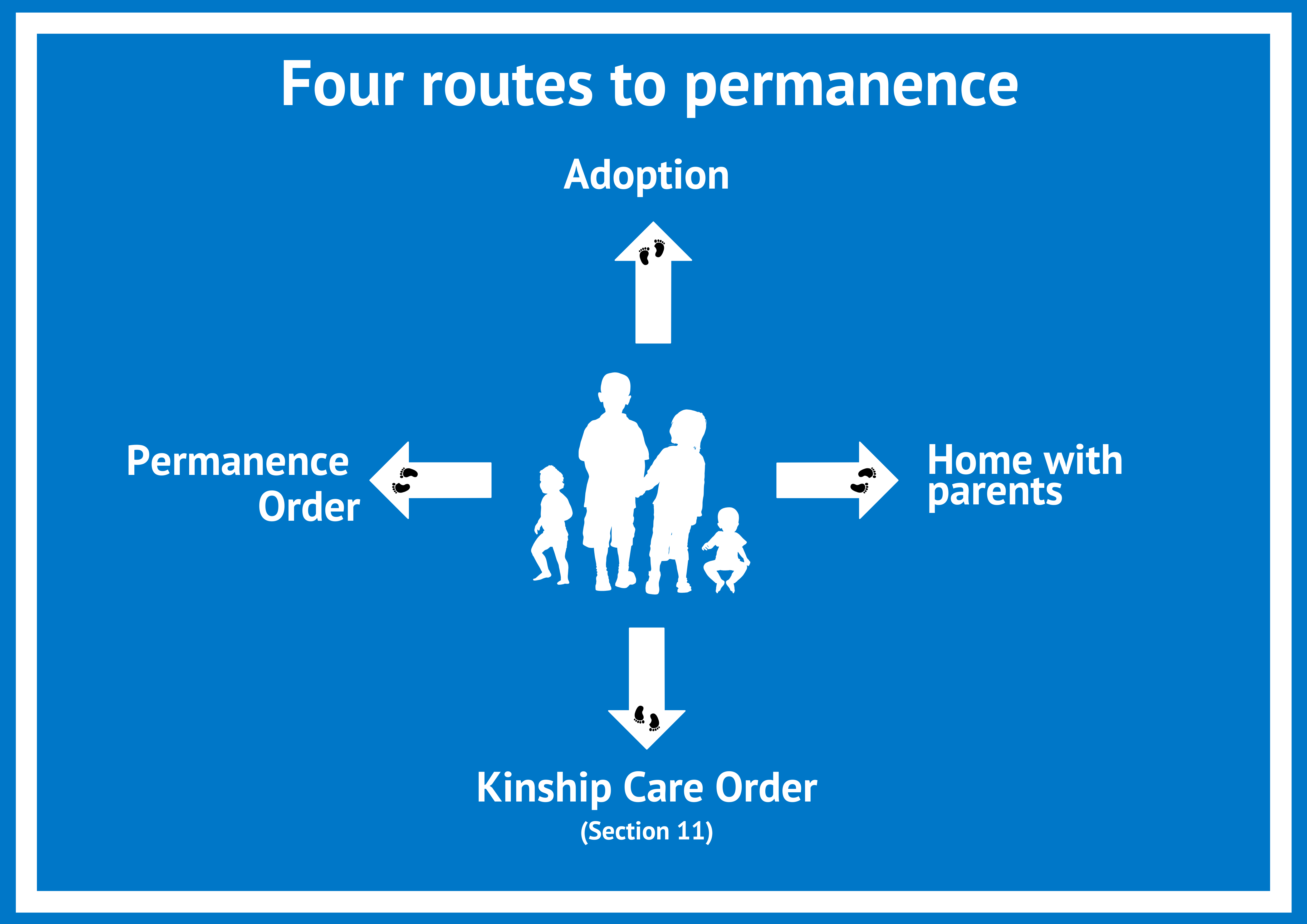
Here, you’ll find a range of information and resources offering an insight into CELCIS’s national Quality Improvement programme: Permanence and Care Excellence (PACE).
The recorded webinars, reports, blog posts, and other resources on this page detail how we used Quality Improvement to support 27 of the 32 Scottish local authority partnerships that embarked on the programme, to reduce timescales in providing a permanent home for babies, children and young people.
What is PACE?
It is every child’s right to have a safe, secure and stable home in which to grow up. For some children, their family life at home can become challenging, for whatever reason, and there is a need for outside support. Local authorities and key agencies involved in permanence decision-making need to work alongside the child and their family to decide what best meets the child’s immediate and long term needs and where their permanent home should be – this is known as permanence planning. This decision making process can often take far too long.
Delays in reaching a decision can lead to children experiencing a period of uncertainty until a final decision is made about their future care (known as permanence, the four possible routes to which are shown in the diagram below). Often, such uncertainty can be prolonged. Many children experience multiple different homes – in kinship, foster or residential care – thus preventing the emotional, physical and legal permanence they have a right to whilst waiting for decisions about their care to be made. Research clearly shows that delays in decision-making about a child’s permanent home can mean poorer life chances for children with the potential to seriously impact on the rest of their lives.

The PACE programme was born out of a need to address these concerns. In 2014, the Scottish Government commissioned CELCIS to develop a whole system change programme to be delivered in partnership with Scottish local authority areas. The aim was to reduce what was identified as drift and delay in permanence planning and prevent the long periods of waiting and uncertainty that so many children experience. At the heart of this objective was that, after a thorough assessment of a child’s unmet needs, permanence decision-making would progress with minimum disruption to enable every looked after child in Scotland to have a safe and secure home to grow up in.
The PACE programme launched in 2014. In total, it was offered to 32 local authorities, embarked on by 27, and by 2020 was completed in 25. The PACE Collaborative, a more condensed, year-long version of the original PACE programme, launched in 2019 and was undertaken by the final five of the 25 areas to complete the programme. The programme concluded in the summer of 2020.
National PACE Aims
National PACE Aims were developed in order to ensure that the improvement efforts in local authority areas were focused on all children who are ‘looked after’ under Scotland’s child protection legislation, regardless of where they were living. These aims also addressed delays in decision making throughout the entirety of the permanence planning process.

Quality Improvement in practice: Learning from the PACE programme
To mark the end of the PACE programme, CELCIS has developed a suite of resources for anyone working in the public sector looking to lead and sustain improvement in local services by using Quality Improvement tools and methodology.
Through a PACE reflections report, a series of recorded webinars, blog posts from those working at the heart of the programme, and other useful resources, we provide a detailed insight into how CELCIS worked alongside the people who deliver the services and know them best, to enable real change for infants, children and young people.
“I hope that in the next five years…the sense of collaboration that has become part of PACE becomes a real sustainable feature of the Scottish childcare landscape.”
Neil Hunter, Principal Reporter at the Scottish Children’s Reporter Administration (SCRA) speaking at Gathering PACE 2018
PACE: the full story
The PACE reflections report, ‘Quality Improvement in practice: leading real change for children’s services’, provides a detailed insight and analysis into each stage of the PACE programme.
It sets out the fundamental ways in which PACE focused on leading and sustaining improvement, including how and why it was set up, engaging with key people and agencies, strengthening the workforce, and the importance of data in Quality Improvement. It provides information on key changes that were tested and implemented, the milestones achieved at each stage, challenges that were overcome, and the overall impact on the lives of the infants, children, young people and their families.
Each section also details the lessons learned at each stage of the programme, which could be applied to Quality Improvement programmes within a variety of settings.
Testing Change Ideas to Improve Permanence Timescales for Looked After Children: Experiences of the Two Week Planning Meeting
The PACE Two Week Planning Meeting report presents qualitative research undertaken in one of the Scottish local authorities involved in the PACE programme.
The research focused on the decisions, activities, and reporting that one local authority partnership undertook when testing a change idea within the PACE programme: Introducing a formal Looked After Child Review meeting at two weeks (‘Two Week Planning Meeting’).
Alongside this, the report examines the impact of that test on professionals and processes within the local authority area.
PACE recorded webinars
To mark the PACE programme drawing to a close, we brought together PACE consultants, frontline practitioners and senior managers in local authority areas to record a series of discussions on key parts of the programme. Through 20 recorded webinars and a wide range of accompanying resources including blog posts, reports and 'how to' guides, we cover a wide range of themes for anyone involved or interested in driving and sustaining improvement in a variety of settings.
The webinars are split into sections, outlined below, which represent the entire Quality Improvement journey from start to finish.

PACE: the first steps
The PACE: the first steps recorded webinars introduce some of the key details of the programme. We provide insight into what is required to secure leadership buy in and engage with key people working in relevant organisations, and discuss each of the four national PACE Aims in detail, including the key change ideas that led to improvements in permanence planning for babies, children and young people.
Watch the recorded webinars
Using Quality Improvement
The Using Quality Improvement recorded webinars provide an insight into how this methodology was used in the PACE programme. Through key themes including data and timelines, in addition to a range of case studies, we look at how Quality Improvement brought about real change for babies, children and young people, and empowered the people who work in services.
Watch the recorded webinars
Permanence in practice
The Permanence in practice recorded webinars look at some of the fundamental themes that surround all four legal routes to permanence (remaining or returning to live with parents; a permanence order; a kinship care order; or an adoption order), including the importance of participation with children and young people, kinship care, assessment and report writing, and concurrency planning.
Watch the recorded webinarsReflections from the PACE Delivery Team
In this final recorded webinar, the PACE delivery team discusses some of the key findings from the PACE programme and how we can use what we’ve learned to help implement The Promise of the Independent Care Review.
Additional resources and further reading
PACE: the first steps
Below are some additional resources to sit alongside the PACE: the first steps page.
- Permanence flowchart
- Child Protection System Map
- Throughcare and aftercare map
- Four Routes to Permanence Poster
- Children's Permanence Leaflet
- Looked After at Home Review Cycle diagram
- Permanence Peer Review Form template, Aim 1
- Questionnaire for Reviewing a Child/Young Person’s Plan to Renew their Compulsory Supervision Order (CSO)
- 2 week child's planning meeting checklist
- Agenda for 2 week child's planning meeting
- Diagram of abbreviated permanence timescales
- Guidance document of the process for a child becoming accommodated pre the permanence review
- Guidance document showing tasks to be completed prior to permanence panel
- Looked After Child review process information leaflet for parents
- Legal advice in permanence planning
- Permanence timescales diagram
Using Quality Improvement
Below are some additional resources to sit alongside the Using Quality Improvement page.
- Forcefield Analysis template
- Driver Diagram template and IHI guidance
- Template for process mapping
- Fishbone template
- Plan, Do, Study, Act (PDSA) template
- Self-sufficiency template
- Scottish Government 3-step improvement guide
- PACE programme change ideas: key examples
- Tried and tested 2018: Local changes that are improving children’s lives through the Permanence and Care Excellence (PACE) programme (2018)
- Beyond The Headlines: Understanding Data (2020)
Timeline resources
- Timeline 'how to' guide
- Timeline example spreadsheet
- Timeline XY chart labeler description
- Child shadows images for use on timelines
- Timeline placement chart details
Permanence in practice
Below are some additional resources to sit alongside the Permanence in practice page.
- Concurrency: Planning for all outcomes (November 2016), Carol Wassell, Permanence Programme and Permanence and Care Team Lead, CELCIS.
- Case for Concurrency Planning (2013), Carol Wassell, Permanence Programme and Permanence and Care Team Lead, CELCIS.
- Pre-birth assessment guidance
- Pre-birth risk/needs assessment
- Pre-birth assessment tool
Voices from PACE
The videos and resources below share the voices of some of the people and organisations involved in the PACE programme.
Gathering PACE events
- Gathering PACE 2018: Resources from the 2018 Gathering PACE event.
- Gathering PACE 2017: Resources from the 2017 Gathering PACE event.
Aberdeen City Council
- Small changes reduce delay in permanence decisions by over 12 weeks (REACH magazine, 2016): Graeme Simpson, Chief Social Work Officer at Aberdeen City Council, explains how small tests of change added up to cutting three months off the time it takes to make decisions for children in their care.
Aberdeenshire
- A Children's Reporter reflects on the impact of PACE (REACH magazine, 2016): Anne MacKenzie, a Children’s Reporter in Aberdeenshire, reflects on the impact of PACE on her work and that of those around her, and on the children they help.
City of Edinburgh Council
- Kinship care: a sense of belonging, a sense of security (REACH magazine, 2016): Kim Irwin, Independent Kinship Care Assessor at City of Edinburgh Council, discusses a three-month-long assessment of kinship care placements.
East Renfrewshire Health and Social Care Partnership
- Planning starts at a very early stage in East Renfrewshire (REACH magazine, 2016): Ruth Nairn, Child Protection Consultant at CELCIS, explains how planning starts at a very early stage.
- What drift and delay really means for children (REACH magazine 2016): Lisa McKenzie, East Renfrewshire Health and Social Care Partnership discusses the improvements they made with the help of PACE.
Dumfries and Galloway Council
- Understanding children's journeys (2018): Alison Penman, Locality Social Work Manager from Dumfries and Galloway Council, explains how her team has been able to use data to help visualise a child's journey through care.
Orkney Children's Panel
- PACE is a real eye opener for Orkney Panel Member (REACH magazine, 2016): Calum Swanson, a member of the Children's Panel in Orkney, explains the difference the PACE programme has made to him and the Children's Panel in Orkney.
Renfrewshire Council
- Case Study: Sometimes the permanent placement is back home (REACH magazine, 2016): Cathie O'Donnell, Renfrewshire Council, explains how through the work of the PACE programme and a multi-disciplinary team, a young boy was able to return home to his family.
Shetland Islands Council
- Visualising the difference (2018): David McQueen, Team Leader, Family Placement Services at Shetland Island Council, explains how data is being used to help support decision making for children and young people in Shetland to achieve better outcomes.
CELCIS
- Contact with their past can give children a sense of belonging (REACH magazine, 2016): Carol Wassell, Permanence lead at CELCIS, works with local authorities and other agencies to help ensure children get good permanent placements as soon as possible.
Blog posts
The blog posts below share the voices of some of the people and organisations involved in the PACE programme.
- Whose experiences are we relying on to explain what the reality of adoption feels like for adoptees? (November 2024): Dr Polly Cowan, a Practice Manager at Scottish Adoption and Fostering
- Developing a new resource to help support adoptive families caring for brothers and sisters (November 2024): Dr Christine Jones, an adoptive parent and researcher
- When data tells us the what but not the why (May 2024): Micky Anderson, Data Lead at CELCIS
- “It’s about…believing our own words”: Bringing together the voices of care experienced people (May 2024): Rebekah Pierre, a care experienced writer, author, social worker and book editor
- ‘Everybody has a different story’: How compassionate connections are helping to support birth parents (November 2022): Melanie Thomson, a Social Worker for the Bluebird Project at Scottish Adoption
- Staying connected: How connections – past and present – can help to write our own futures (November 2022): Tegan, a Youth Ambassador at Scottish Adoption
- Therapeutic Parenting in adoption (November 2020): Fiona Aitken, Director of Adoption UK Scotland
- We need to talk about FASD (November 2020): Barbara Ogston, FASD Advisor in the FASD Hub Scotland
- Finding the ‘invisible’ adopters (August 2020): Leanne McIver, Research Associate at CELCIS
- Considered but timely decision making is vital for children (November 2019): Stephen Small, Director, St Andrew’s Children’s Society.
- PACE is changing (March 2019): Carol Wassell, Permanence Programme and Permanence and Care Team Lead, CELCIS
- Information is power (September 2018): Laura Conachan, Projects Lead, Children’s Hearings Scotland.
- Infants may not be able to speak but their voice is important (October 2017): Linda Davidson, Permanence Consultant, CELCIS.
- Children can easily become lost in the system, but a timeline can help you see them (February 2017): Linda Davidson, Permanence Consultant, CELCIS.
- A Passion for Permanence (November 2016): Aileen Nicol, Head of Improving Permanence and Protection, CELCIS.
- Knowing what we need to know, when we need to know it (November 2016): Diana Beveridge, Improvement Advisor, Scottish Government.
- Legal opinion: We can do our bit to cut down drift in permanence planning (November 2016): Jennifer McKearney, Principal Solicitor, Aberdeenshire Legal and Governence Department.
- Concurrency: Planning for all outcomes (November 2016): Carol Wassell, Permanence Programme and Permanence and Care Team Lead, CELCIS
- Peer support is empowering social workers in East Renfrewshire (November 2016): Lesley-Ann Stewart, Social Worker, East Renfrewshire.
- Case study: Dumfries and Galloway Council's work with PACE (November 2016): Mareen Vernon, Dumfries and Galloway council.
Looking for more information or support?
Get in touch with our Permanence Team, we’d be delighted to hear from you.



